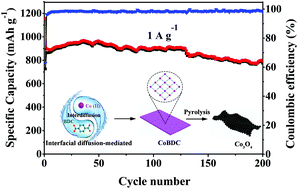Facile synthesis of Co3O4 nanosheets from MOF nanoplates for high performance anodes of lithium-ion batteries†
Abstract
Cobalt oxides, typically Co3O4, have been recognized as a candidate for electrode materials, benefiting from their high theoretical energy density and remarkable rate performance. However, low electrical conductivity and large volume changes easily lead to poor cycling and rate performance, thus limiting their application. Nanonization of the materials is an effective strategy to improve the electrochemical performance. Herein, we synthesized two-dimensional Co-based MOF nanoplates (CoBDC) based on Co2+ and BDC2− ligand (H2BDC = 1,4-benzenedicarboxylic acid) by an interfacial diffusion-mediated control method without any surfactants. Then, wrinkled porous Co3O4 nanosheets were obtained from the CoBDC precursor through a pyrolysis process in air and further investigated as anode materials for lithium ion batteries. The Co3O4 nanosheets exhibit a remarkable specific capacity of 1477 mA h g−1 at a current density of 100 mA g−1 after 160 cycles, and 775 mA h g−1 at 1 A g−1 after 200 cycles. Furthermore, the Co3O4 nanosheets show excellent rate performance, with a specific capacity as high as 580 mA h g−1 even at 10 A g−1.

- This article is part of the themed collection: Inorganic Chemistry Frontiers HOT articles for 2018


 Please wait while we load your content...
Please wait while we load your content...